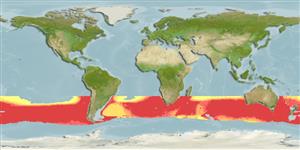>
Stomiiformes (Lightfishes and dragonfishes) >
Stomiidae (Barbeled dragonfishes) > Idiacanthinae
Etymology: Idiacanthus: Greek, idia = own privative + Greek, akantha = thorn (Ref. 45335).
Environment: milieu / climate zone / depth range / distribution range
Ecologie
marien bathypelagisch; diepte 1239 - 2000 m (Ref. 58018). Deep-water; 25°S - 60°S
Subtropical to temperate waters in the southern hemisphere, probably limited by the subtropical convergence. Incidentally found in sub-Antarctic waters of the Southern Ocean.
Grootte / Gewicht / Leeftijd
Maturity: Lm ? range ? - ? cm
Max length : 53.0 cm SL mannelijk / geslacht onbekend; (Ref. 7249)
Korte beschrijving
Morfologie | Morfometrie
Dorsale stekels (totaal): 0; Dorsale zachte stralen (totaal): 55-63; Anale stekels 0; Anale zachte stralen: 37 - 42. Pelvic fins with 6 rays (females), absent in males.
Mesopelagic species (Ref. 75154). Pronounced sexual dimorphism: females are black, with well developed canine teeth, barbel and pelvic fins with six stripes. Males are dark-brown, have no teeth on maxilla and neither barbel nor pelvic fins (Ref. 47377). Apparently, females live below 500 m during the day and perform vertical migration at night to shallower depths; males always in deep water, ca 1,000-2,000 m (Ref. 5169).
Levenscyclus en paargedrag
Maturiteit | Voortplanting | Paaien | Eieren | Fecunditeit | Larven
Krueger, W.H., 1990. Idiacanthidae. p. 341-342. In J.C. Quero, J.C. Hureau, C. Karrer, A. Post and L. Saldanha (eds.) Check-list of the fishes of the eastern tropical Atlantic (CLOFETA). JNICT, Lisbon; SEI, Paris; and UNESCO, Paris. Vol. 1. (Ref. 7249)
Status op de Rode Lijst van het IUCN (Ref. 130435)
Gevaar voor de mens
Harmless
Gebruik door de mens
Visserij: van geen belang
Meer informatie
Leeftijd/GrootteGroeiLengte-gewichtLengte-lengteLengtefrequentiesMorfometrieMorfologieLarvenLarvale populatiedynamiekRekruteringAbundantieBRUVS
ReferentiesAquacultuurAquacultuurprofielKweeklijnenGeneticaElectrophoresesErfelijkheidZiektesVerwerkingNutrientsMassaconversie
Tools
Speciale rapporten
Download XML
Internetbronnen
Estimates based on models
Preferred temperature (Ref.
123201): 2.1 - 3.7, mean 3.1 °C (based on 311 cells).
Fylogenetische diversiteitsindex (Ref.
82804): PD
50 = 0.6250 [Uniqueness, from 0.5 = low to 2.0 = high].
Bayesian length-weight: a=0.00389 (0.00180 - 0.00842), b=3.12 (2.94 - 3.30), in cm total length, based on all LWR estimates for this body shape (Ref.
93245).
Trofisch niveau (Ref.
69278): 4.0 ±0.7 se; based on size and trophs of closest relatives
Weerstandsvermogen (Ref.
120179): laag, minimale populatieverdubbelingstijd 4,5-14 jaar (Preliminary K or Fecundity.).
Fishing Vulnerability (Ref.
59153): Moderate to high vulnerability (46 of 100).
